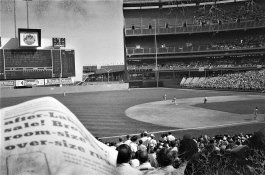Steve Cohen
Member
I've recently found a box of old, exposed, but undeveloped black and white film -- Tri-X. This stuff is likely about 50 years old! It was stored in the original canisters in an old wooden cigar box.
Hoping that there would still be an image, I brought two rolls to a local lab, and asked them to develop it. They ran it through their normal process, which uses something called F-76 (a knockoff of D-76) and we push processed it a bit (ie. over developed it).
And sure enough, there is still an image there. I chose to have the lab do a low-res quickie scan, rather than a conventional contact sheet. I've got a scanner rig based on a Sony A7II, which I'll use to do better scans.
But there's a big problem -- a spiderweb/tree-shaped pattern of lines creeping in from the edges of the film. One roll is much worse than the other, but they both have it. Sample attached -- from a blank frame at the head of the roll.
I'm guessing this is either mold or some kind of static charge that created a latent image.
Has anybody seen this before? Do you know what it is? And more to the point, I've got another dozen rolls or so that have yet to be developed. Is there anything I can do prior to developing to minimize it?
Many thanks!
Steve

Hoping that there would still be an image, I brought two rolls to a local lab, and asked them to develop it. They ran it through their normal process, which uses something called F-76 (a knockoff of D-76) and we push processed it a bit (ie. over developed it).
And sure enough, there is still an image there. I chose to have the lab do a low-res quickie scan, rather than a conventional contact sheet. I've got a scanner rig based on a Sony A7II, which I'll use to do better scans.
But there's a big problem -- a spiderweb/tree-shaped pattern of lines creeping in from the edges of the film. One roll is much worse than the other, but they both have it. Sample attached -- from a blank frame at the head of the roll.
I'm guessing this is either mold or some kind of static charge that created a latent image.
Has anybody seen this before? Do you know what it is? And more to the point, I've got another dozen rolls or so that have yet to be developed. Is there anything I can do prior to developing to minimize it?
Many thanks!
Steve








